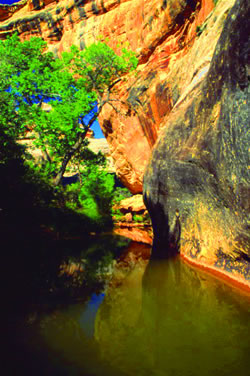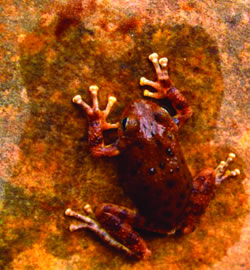As
I reach Sipapu Natural Bridge in the pre-dawn darkness,
I hear the far-off bleating of sheep. Or what seems
to sound like sheep. Though I am here to conduct early
morning breeding bird surveys, I can not ignore these
sounds.
As I round a bend in the canyon, the bleating stops.
When I stop, the bleating continues. Eventually the trail
crosses the boulder-strewn creek and I catch the trailing
segment of sound coming from a nearby pool. Upon closer
inspection of the pool I find frogs ─ canyon treefrogs
that leap from the banks or boulders into the safety
of the pool.
Though the frogs are difficult to locate because of their
cryptic skin color, which closely resembles the sandstone
wall, they are easy to locate when they jump. Their aquatic
escapes are brief as the frogs haul themselves out of
the pool and perch on a rock or cling to the canyon wall.
There, they continue to call.
The males are calling to advertise their availability
for mating, and from the sounds of things, there are
quite a few bachelors in the hood.
When the males chorus, their vocal sacs (located below
their chins) inflate like a dusky, opaque balloon. This
vocal sac enables the call to resonate and project beyond
the pool. The “community chorus” draws the
females to the pools, but I do not know if the females
select the best singers in the bunch.
In Larry Hyslop’s Beeplants and Whiptails he describes
an encounter with treefrogs in Zion National Park, “Across
the pond, the now familiar call of a male frog is a sound
much too loud for such a small frog. It is nothing humans
would call beautiful although I assume it sounds good
to a female frog.” Others describe this call as “the
bleating of a sheep with a cold” or “…sounds
like brrurt-brrurt-brrurt, like a rivet gun coming from
inside a tin can.”
What these frogs lack in size, they make up in voice.
Adults are 1¼-2¼” long and have an
ash-gray to dark brown skin. There are spots or darker
blotches on the upperside of the plump body, while the
underside is white or cream colored.
Their toe pads are shaped like
suction cups to provide a better grip on vertical
surfaces. The pads have tiny divisions that spread
apart and enable the frog to gain a better grip on
surfaces. The last two bones of each toe have extra
cartilage segments between them, enabling the frog
to swivel their toe and place it flat against a surface.
Their long legs also allow them to make sizeable
leaps.
The breeding season runs from March to August, depending
upon temperature and elevation. Generally, evening
water temperatures should be above 55°. The warmer
the water the faster the eggs develop.
The tadpoles mature into adults in about 70 days.
They are vulnerable to predation by fish, aquatic
invertebrates, small mammal predators, and salamander
larvae. An estimated 2% of the eggs will mature into
adults, and of this amount, around 10% will survive
the first year.
The treefrog’s scientific name is Hyla arenicolor.
Although Hyla means, “tree” this species
spends little time in trees or shrubs. Arenicolor
means, “sand color or tone” and refers
to the skin color. The remarkable thing about their
skin is that it can change color to match its surroundings.
Like many amphibians, treefrogs occur in aquatic
locations such as streams, potholes or stocktanks.
Their unique respiratory system includes lungs for
breathing but may also utilize a cutaneous respiration
system to supply oxygen to their body. Air is drawn
in through the moist skin via blood vessels that
lie just below the skin’s surface. This enables
the frog to stay submerged while avoiding predators
or curious biologists.
Though the frogs had quieted down long before I ascended
out of the canyon, I was pleased to hear their choruses
in the early morning. Even if they did sound like
a flock of rivet-popping, runny-nosed sheep. |





|